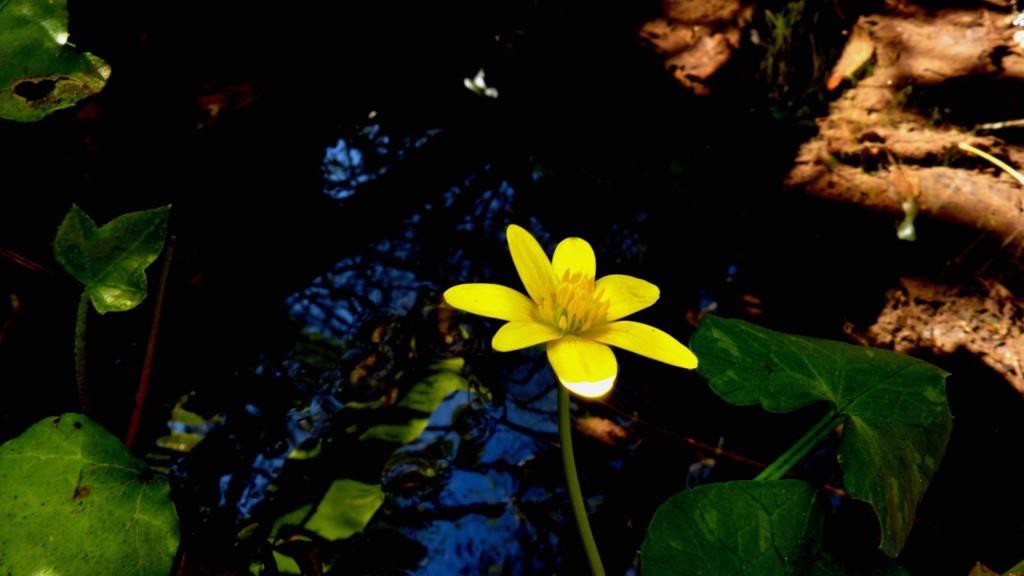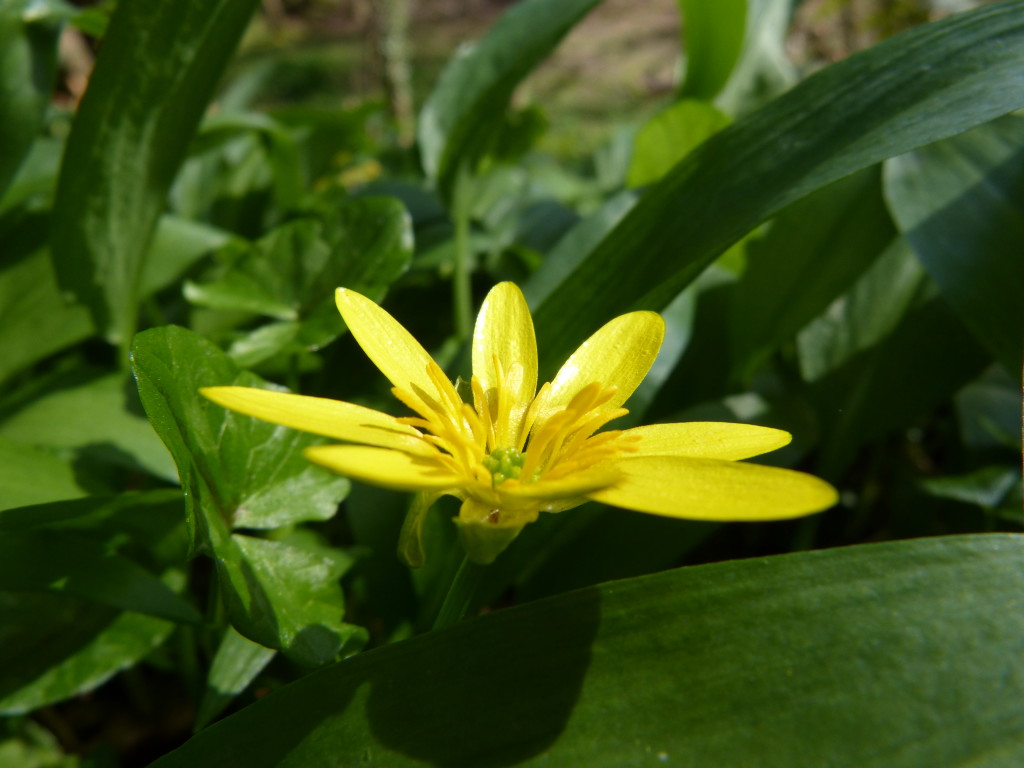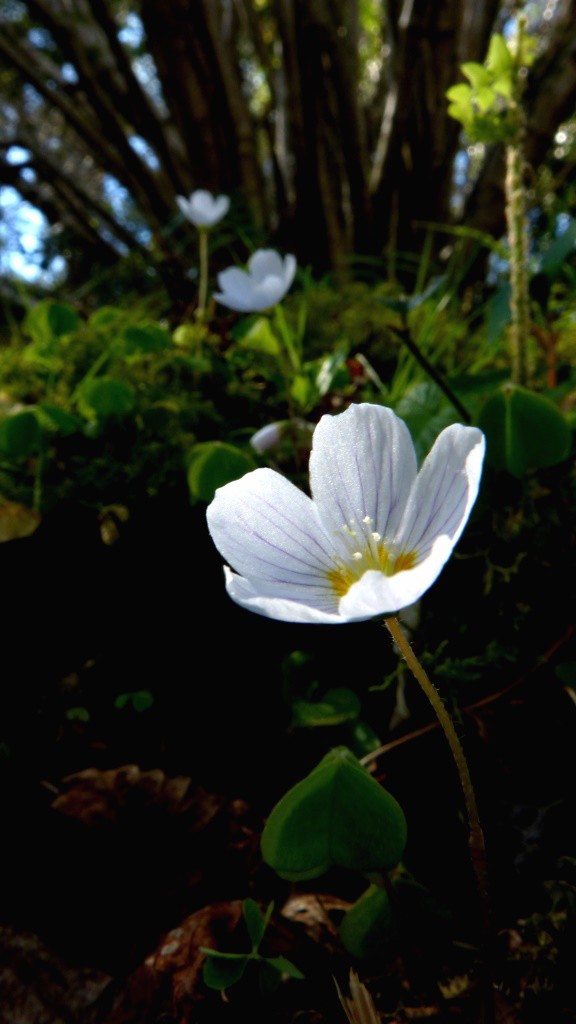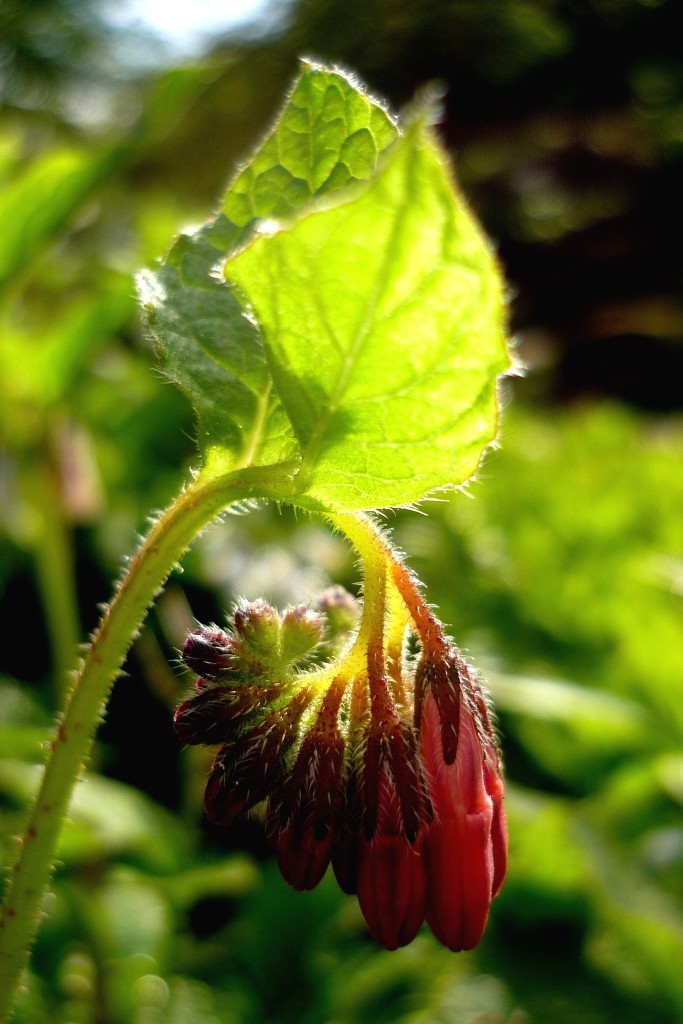By Sean Fagan

By a woodland pool...Lesser Celandine (Ficaria verna). It’s easy to imagine strong, prehistoric hands gently digging through the damp soil of woodlands for the energy-rich roots of this member of the buttercup family (Photo: Sean Fagan, County Wicklow, Ireland)
.
.
Toxic vs Edible Wild Plants?
The well-known English romantic poet, William Wordsworth, was quite enamored with the beauty of lesser celandine, as herbalist Mrs M. Grieve once wrote:
“Wordsworth, whose favourite flower this was (in recognition of which the blossoms are carved on his tomb), fancifully suggests that the painter who first tried to picture the rising sun, must have taken the idea of the spreading pointed rays from the Celandine's glittering countenance”.
.

Throughout winter and early spring the glossy-yellow, star-shaped flowers of lesser celandine add a vivid burst of bright yellow among the muted colours of woodlands, roadsides, rivers and hedge-banks (Photo: Sean Fagan).
.
As an early season bloomer, lesser celandine, Ficaria verna, relies on reserves of starch stored within its swollen, underground tubers for that initial spurt of growth in winter or early spring.
This starch was a resource that was most probably utilised by hunting and gathering people in the distant past.
Most likely such prehistoric people availed of this starch throughout lesser celandine’s native range of Europe and west Asia - providing a much needed boost of calories on their nomadic forays throughout the pressing months of winter and early spring.
It was simply too good a food source to pass by.
There is even some archaeological evidence to support this theory... "On Oronsay in the Hebrides, Scotland - deposits of charred tubers and bulbils (of lesser celandine) have been found around ancient Mesolithic settlements" ~ Robin Harford.
.
The ambiguity of Lesser Celandine as a wild edible...
.
Lesser celandine is a good example of a wild edible somewhat shrouded in ambivalence.
The underground tubers and the leaves of this plant species are regarded as edible throughout much of the wild food literature.
Often, the tubers and leaves are regarded as edible - only after they have been processed.
The processing of the toxic leaves into a safe edible is apparently simple - once the leaves are exposed to heat or drying - the potentially harmful chemical contained within the leaves, protoanemonin, is rendered harmless.
It's also believed that the leaves are edible raw and unprocessed - before the plant starts to flower - as the leaves have not yet accumulated harmful levels of protoanmonin at this early stage of their development.
Then there is the added complication of the leaves of this plant being used, historically, as a wild food edible (Sailors from the middle ages would often store the leaves of this plant on ships as a preventative measure against that dreaded maritime disease - scurvy).
See what I mean?
It’s complicated. And I haven’t even touched upon its supposed medicinal uses (except as an anti-scorbutic).
It also doesn’t help that some of the wild food foraging literature is often mired with half-truths, lies and exaggerations.
.
As regards the leaves of lesser celandine – I simply don’t eat them.
I like to be practical about the whole subject - and rather unglamorously err on the side of caution.
Even the tubers might contain toxins so I always cook them well and to be honest I don't eat that many as they are at their best during that brief phase when the leaves first appear from the soil.
During that short phase, the tubers are at their fullest - but will soon deplete in size as the emerging aerial parts of the plants (stalk, flowers and leaves) increasingly draw upon the reserves of stored starch to continue growing (until the leaves start to procure sufficient energy through their own photosynthesis).
.
However, if I was ever thrust into a survival situation then I would be the first to dirty my hands digging up the starchy roots of lesser celandine (if available).
Because when it comes to hunger in a dire situation – easily acquired, long-burning energy such as starch is king!
But I still probably wouldn’t eat the leaves.
I simply don’t need to and scurvy is hardly a risk I need to mitigate in a short-term survival situation (besides, there is nearly always some alternative foliage in the vicinity that is safer to eat and just as nutritious – even in winter. Another compelling reason to hone your plant ID skills).
.
So I don’t eat lesser celandine leaves.
I know some people eat the leaves.
That’s their choice.
But I generally advise folk to not eat the leaves.
Why? Because there is some ambiguity regarding the toxicity of lesser celandine leaves in the literature.
And believe it or not, the science of wild plants, regarding their edibility or toxicity, is still developing.
For example, the rhizomes and young fronds of bracken (Pteridium spp.) was traditionally considered a good, wild edible in many parts of the world and was even considered a delicacy in Japan and a staple food among the Maori people of new Zealand.
Scientific studies of the micro-structure of bracken roots have revealed that the root is not necessarily rendered harmless even after much processing.
.
Other edible plants that should only be eaten sparingly...
.
In a similar vein to my frugal consumption of lesser celandine tubers - there are other plants I only eat sporadically and not in great amounts at any one sitting.
Plants such as wood sorrel, Oxalis acetosella.
.

An attractive trio of wood sorrel in bloom (Photo: Sean Fagan, County Wicklow, Ireland).
.
The charming little wood sorrel contains oxalic acid which bestows this plant its wonderfully sour taste (great as a punchy addition to wild salads and other dishes). But I avoid eating too much wood sorrel precisely because of its oxalic acid content.
Excessive oxalic acid can cause or exacerbate kidney stones for example. And who really wants to possibly encourage a potential health issue that can make a grown man weep in pain?
But a word of caution - individual reactions to oxalic acid can vary. For most people they would have to consume quite large amounts of wood sorrel to be at risk (for more information, check this link: notes on oxalic acid).
The wood sorrel is a prime example of a plant that should, most likely, be eaten sparingly. There are quite a few others.
.

Some developing flowers of comfrey (Symphytum officinale). Although a much venerated edible and medicinal wild plant, comfrey should be consumed sparingly as it contains certain chemicals that can cause harm if eaten in excess (Photo: Sean Fagan - County Dublin, Ireland).
.
.
What to do next...
.
Wild plant foraging, for better or worse, is becoming a lot more popular.
There would seem to be a belief among some that correctly identifying a plant down to species level is the only hurdle that needs to be overcome as regards knowing if a plant is toxic or safe to eat.
It's often not the case though - and I hope this blog post has strongly conveyed this reality.
.
Here are my suggestions for tackling the thorny subject of edible wild plants...
.
Firstly, research is vital - your own research (I strongly advise you bring a journal and a compact/phone camera to record the small-but-important details of wild plants when outdoors)
Secondly - cross reference! Which means rummaging through the literature, both widely and deeply, to pick up any connective threads regarding wild edible plants.
What this means is reading from a number of reputable sources.
.
But books will get you only so far.
Theory combined with practise is where it's at.
So, on a more practical note...
.
Avail of reputable plant identification courses.
Its best to go out in the field with an expert but there are some great online plant identification courses out there.
Consider joining clubs that specialise in plant identification.
Where I live (Dublin city) - the Dublin Naturalist Field Club do a lot of great outings which focus primarily on the area of plant identification (link to club at end of article). They have a number of highly qualified, experienced botanists among their members.
If you can go out in the field with a professional wild food forager. Robin Harford is a good example of a reputable, professional wild food forager.
There are also some great herbalists that do good field courses.
When all is said and done - there is nothing like bringing a good plant identification guide with you along with your journal and camera. Record, sketch and photograph the details of wild plants (include date and habitat) until they become indelibly imprinted into the long term memory.
..
It was certainly not my aim in this article to muddy the waters of wild plant foraging.
I love foraging for wild plants - the whole process of finding a wild edible plant - of noticing its botanical details and intrinsic beauty - of touching, smelling and tasting them - of adding them to outdoor dishes.
It's a very gratifying way of broadening the palette with the often unique, mostly strong flavours of wild plants.
It's also another way of getting close to nature.
.
Do I think that eating wild plants will generally improve your health? Absolutely!
Most edible, wild plants simply blast away the majority of mainstream western foods in terms of nutritional value.
But they must be eaten judicially – often after proper preparation, and often throughout a part but not all of the year. Then there is the matter of certain parts of the plants being edible while other parts are not.
.
To recap, a brief summary:
- Research broadly and widely from reputable sources about edible wild plants - cross reference!
- Theory is very limited when it's not combined with good outdoor practise.
- Join a good plant identification club (there are some great online groups - Facebook has some fantastic plant ID groups)
- There are some great online plant identification courses out there - doing an online course allows for a more systematic approach to plant ID - which is important for understanding the connective similarities between related plants and the families they belong to.
- Accompany a good herbalist or wild food forager into the field - one of the best ways to learn about wild edible plants.
- Don't shy away from bringing a good field guide into the field (for those bushcrafters/hikers out there - don't begrudge the weight!). There are of course digital versions of books, look into them.
- Combine your field guide with a journal and some means of visually recording plants (a compact or phone camera will suffice - a sketchpad is, in my opinion, even better).
.
Well, that’s the kettle boiled – time for one of my favourite herbal teas…nettle and dandelion leaf tea with a few slices of ginger.
Might even throw in some water mint.
.
An invigorating, wholesome beverage…
.
…and very nice with a packet of crisps : )
.
.
Happy and safe foraging,
Sean.
.
.
Related articles on this website:

Recent Comments